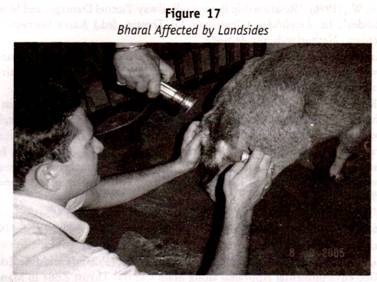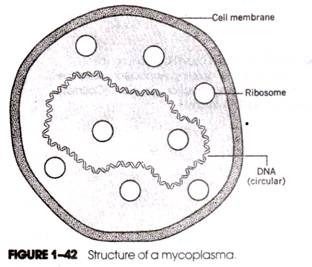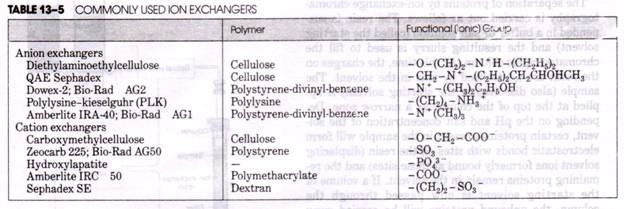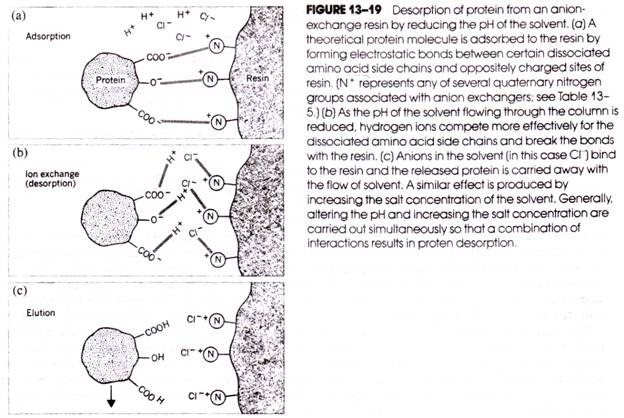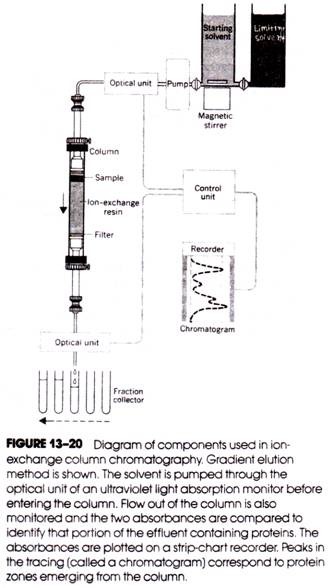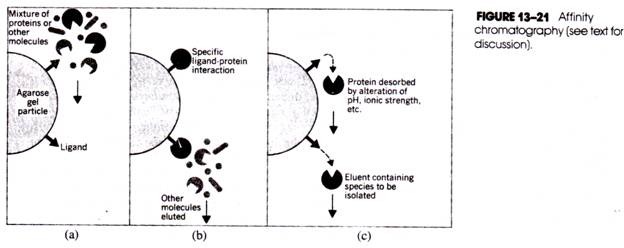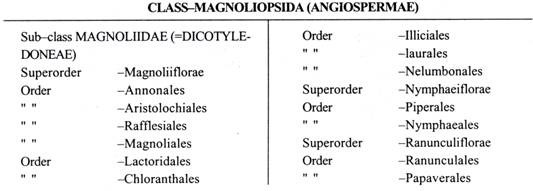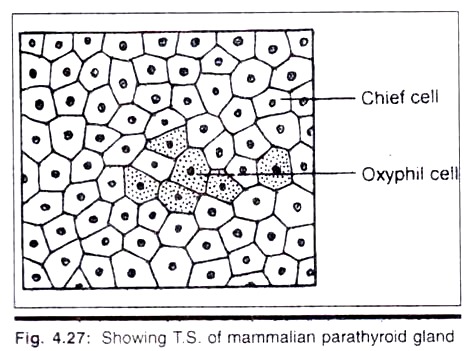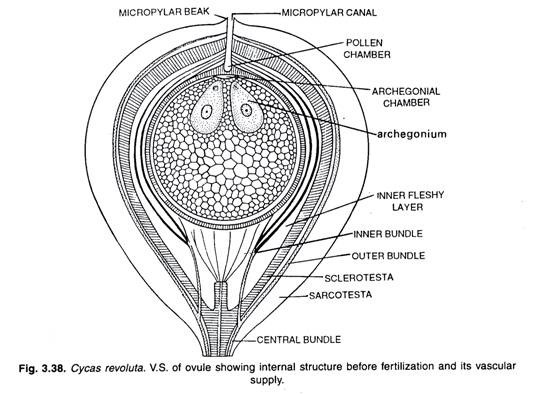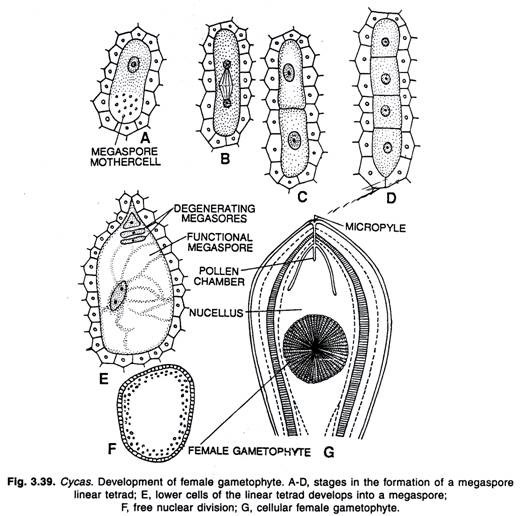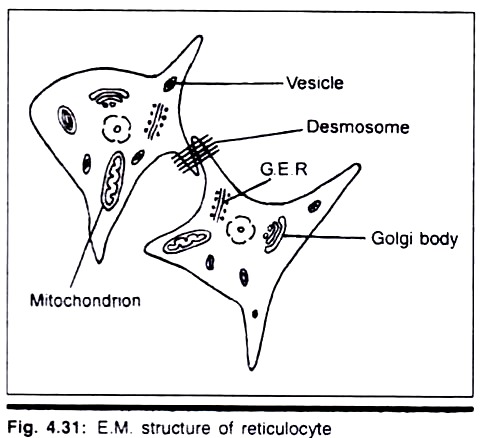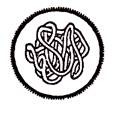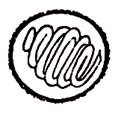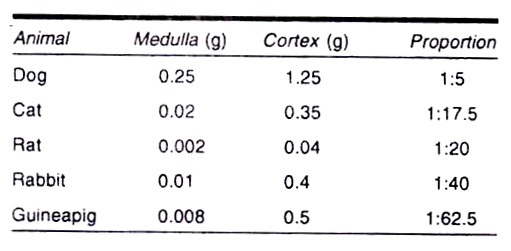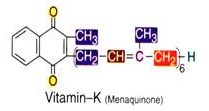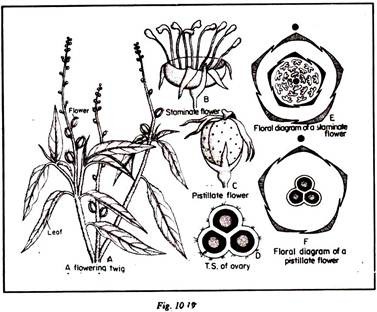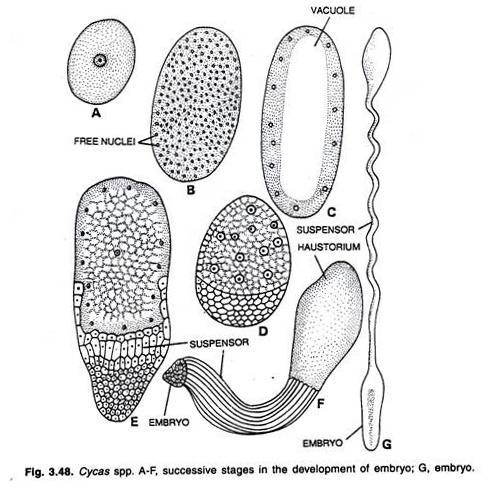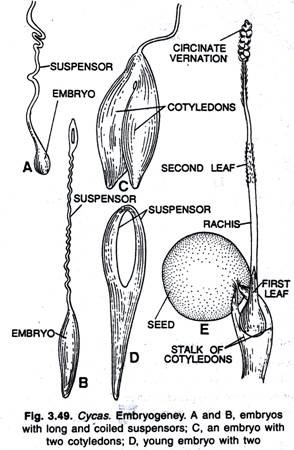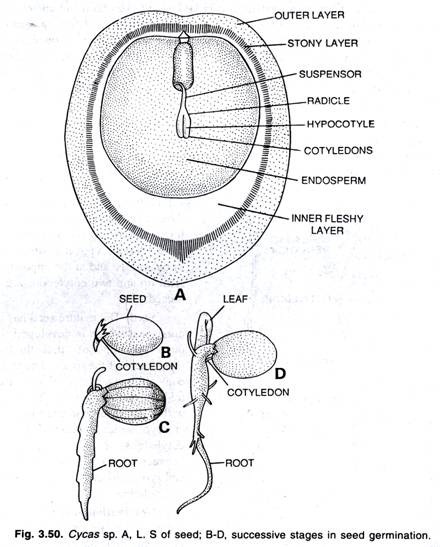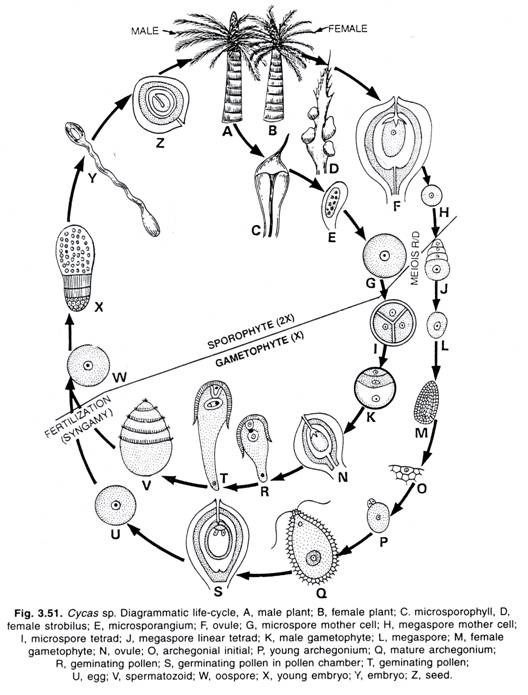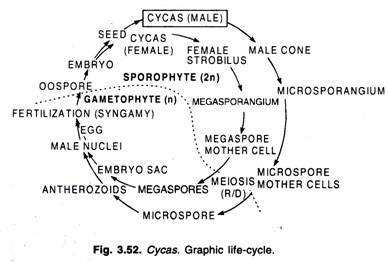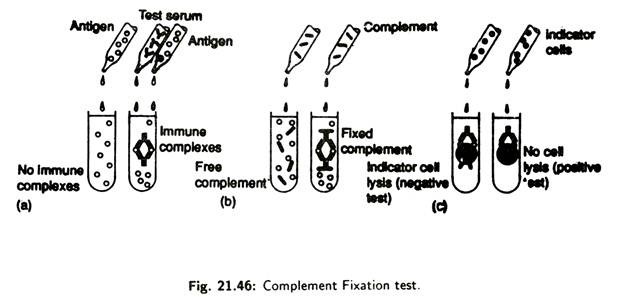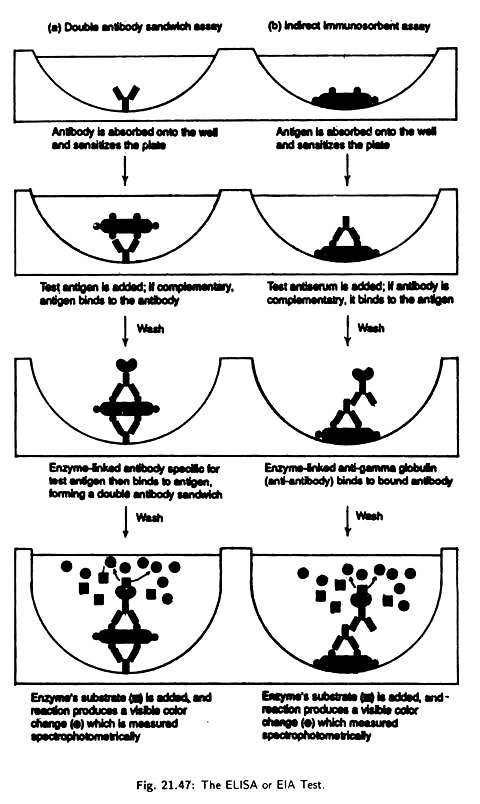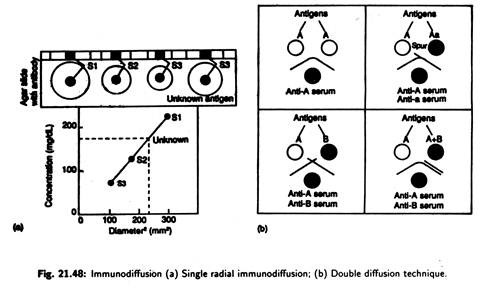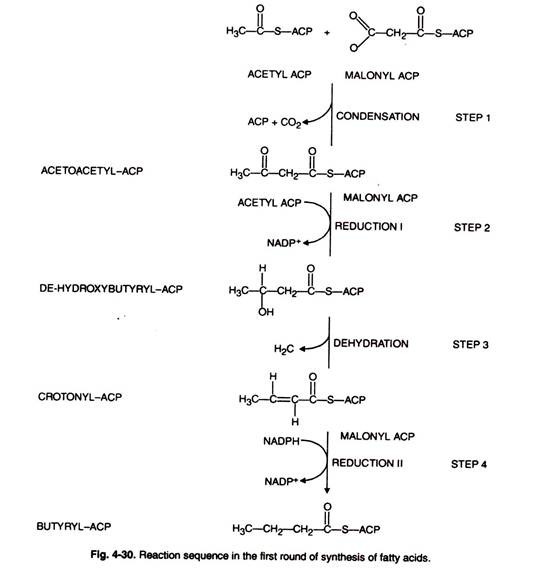Here is a list of twenty-eight types of stems found in plants.
1. Stem of Helianthus Annuus (Sunflower. Family Asteraceae: Internal Structure before Secondary Growth):
The transverse section through the internode of stem is more or less circular in outline and exhibits the following arrangement and structure of tissues from periphery towards centre (Figs. 31.1, 31.1A).
Epidermis:
The outermost layer is the epidermis. It is uniseriate and composed of living parenchyma cells. The cells are more or less tabular in shape, contain vacuolated protoplast and remain attached with the adjacent cells by their radial walls. There are no intercellular spaces and the continuity of the epidermis is sometimes interrupted by the presence of stomata. The outer walls are cuticularized and many multicellular hairs occur on them.
Cortex:
The zone between the stele and epidermis is referred to as cortex. It is differentiated into hypodermis, general cortex and endodermis.
Hypodermis:
It is the peripheral layer of cortex and is adjacent to epidermis. It is composed of few layers of collenchyma cells that are of angular type. Collenchyma cells occur as a continuous band.
General cortex:
This zone occurs between hypodermis and endodermis. It is many layered and composed of parenchyma cells that are thin walled, oval or spherical, large with profuse intercellular spaces. In this zone, there occur here and there the secretory ducts, which are lined by small epithelial cells with dense protoplasm.
Endodermis:
It is the innermost layer of cortex and demarcates cortex from the stele. It is a continuous layer, somewhat wavy in outline and is composed of parenchyma cells, which are barrel-shaped, compactly set without any intercellular spaces. These cells contain abundant starch grains and so this layer is often referred to as starch sheath.
Stele:
It consists all the tissues that occur internal to endodermis. It is composed of pericycle, vascular bundle, medullary ray and pith. The stele is siphonostele due to the presence of pith and eustele as the open collateral vascular bundles are arranged more or less in a ring.
Pericycle:
It is the peripheral layer of stele and lies internal to endodermis. It is many layered and composed of parenchyma cells and sclerenchyma patches. The parenchyma cells are thin walled and loosely arranged. Sclerenchyma cells occur as patches over the primary phloem and are known as bundle cap. The sclerenchyma cells are actually the phloem fibres and so they are often referred to as hard bast.
Vascular bundle:
The vascular bundles are arranged more or less in a ring. Xylem and phloem together constitute the vascular bundle where the former is situated towards the centre and the latter is present on the peripheral side. In between the two, there occurs the cambium often called fascicular cambium. The cells of cambium are few layered, more or less rectangular in appearance and are storied.
Xylem consists of protoxylem and metaxylem, which occur towards the centre and peripheral side respectively. As the proto- and metaxylem show centrifugal mode of differentiation, the vascular bundles are endarch. In the protoxylem elements, tracheids and trachea are of smaller diameter with characteristic spiral and annular thickenings. In the metaxylem, tracheids and trachea are of larger diameter with pitted and other type of thickenings.
Medullary rays:
The cells of medullary rays are parenchymatous of various shapes, and occupy regions between the two vascular bundles. These narrow wings of parenchyma at the interfascicular region are in continuation with pith. In this region the secondary meristem interfascicular cambium originates at the time of secondary growth.
Pith:
It is also known as medulla that is the innermost central region of stele. It is large and composed of parenchyma of various shapes with abundant intercellular spaces.
Comment:
Cuticularized epidermis protects the inner tissues and checks the loss of water. Collenchyma cells present at hypodermis add mechanical rigidity to the stem. Xylem and sclerenchymatous bundle caps are mechanical cells. The sclerenchymatous bundle caps form the flanges of I-girder and they form a composite I-girder that provides mechanical rigidity against inflexibility.
Secondary increase in thickness of the stem occurs through cambium. Dicotyledonous nature of stem is revealed due to the presence of collateral and open vascular bundle without bundle sheath and their ring like arrangement, and large parenchymatous pith.
2. Stem of Cucurbita (Family: Cucurbitaceae):
In transverse section, the stem is wavy in outline with distinct ridges and furrows. The following internal tissue organization is exhibited from periphery towards the centre (Fig. 31.2).
Epidermis:
It is uniseriate and composed of living parenchyma cells. The cells are more or less tabular in shape, contain vacuolated protoplast and remain attached with the adjacent cells by their radial walls.
There are no intercellular spaces and the continuity of epidermis is sometimes interrupted by the presence of stomata, which are situated at the apices of small projections and raised above the general level of epidermis. The outer walls of epidermal cells are cuticularized and many multicellular hairs occur on them.
Cortex:
The zone between the stele and epidermis is referred to as cortex. It is differentiated into hypodermis, general cortex and endodermis.
Hypodermis:
It is the peripheral layer of cortex and lie adjacent to epidermis. It consists of collenchyma and chlorenchyma cells. The collenchyma cells are not in a continuous band and interrupted by patches of assimilatory tissues like chlorenchyma extending to the epidermis. The collenchyma, below the ridges, is several layered, which become few layered internal to furrow. Chloroplasts may occur in some collenchyma.
General cortex:
This zone occurs between hypodermis and endodermis. It is few layered and composed of parenchyma cells that are thin walled, larger in size and contains lesser number of chloroplasts than chlorenchyma cells.
Endodermis:
It is the innermost layer of cortex and demarcates cortex from the stele. It is a continuous layer, somewhat wavy in outline and is composed of parenchyma cells, which are barrel-shaped, compactly set without any intercellular spaces. These cells contain abundant starch grains and so this layer is often referred to as starch sheath.
Stele:
It consists of all the tissues that occur internal to endodermis. It is composed of pericycle, vascular bundle, medullary rays and pith. The stele is siphonostele due to the presence of pith.
Pericycle:
It is the peripheral layer of stele and lies internal to endodermis. It is many layered and consists of sclerenchyma and parenchyma cells. The sclerenchyma is present internal to endodermis, few layered and occurs as a continuous band. Internal to this layer a few layers of parenchyma are present. These cells form a continuous ring and extend up to the outer ring of vascular bundles. The continuous ring of peripheral sclerenchyma and inner parenchyma constitute the pericycle.
Vascular bundle:
The number of bundles may be more than ten and they are arranged more or less in two distinct circles accompanied by accessory bundles. Each circle consists of about five bundles. The bundles are of two sizes and widely separated by broad strips of medullary rays. The smaller bundles compose the outer ring and are situated below the ridges.
The inner ring is formed by the large bundles, which are present below the furrows – meeting at the pith. Each vascular bundle is bicollateral and open. The arrangement of vascular tissues from periphery towards the centre is as follows: outer phloem, outer cambium, xylem, inner cambium and inner phloem. The outer cambium is many layered and storied.
The inner cambium is curved and few layered. The outer phloem is more massive than inner one and contains sieve tubes, which are wide with conspicuous transverse sieve plates. Companion cells and phloem parenchyma are also present in the phloem elements. In the xylem elements tracheids, trachea, xylem fibre and xylem parenchyma are present.
The xylem is endarch where the proto- and metaxylem are situated towards the inner-and outer phloem respectively, and they are not in radial rows. The vessels have conspicuous wide Iumina with simple perforations. Tylosis is very common in the metaxylem. Metaxylem vessels have pitted thickenings while protoxylem vessels possess annular and spiral thickenings.
Medullary ray:
The cells of medullary ray are parenchymatous of various shapes and occupy regions between the two vascular bundles. They are broad and continuous with the pith. In this region interfascicular cambium originates at the onset of secondary growth.
Pith:
The pith is hollow, i.e. there is no tissue at the centre.
Comment:
Epidermis with cuticle is protective tissue. Stoma is meant for gaseous diffusion. At hypodermis the chlorophyllous parenchyma is the photosynthetic tissue and the collenchyma cells are mechanical cells.
The dicot nature of the stem is revealed due to the presence of pith in the stele, arrangement of vascular bundles in rings, bicollateral and open vascular bundles. Anomaly in the stele is due to the formation of secondary xylem and phloem in individual vascular bundles only in mature stems.
The outer cambium forms the secondary vascular tissues only. At interfascicular region parenchyma cells are only formed. The plant is a climber and it is revealed by the presence of large metaxylem vessel, wavy pericycle and, presence and formation of parenchyma between vascular bundles. The xylem is the mechanical cell and provides mechanical rigidity against inflexibility. Presence of parenchyma at the interfascicular region adds flexibility to the stem during climbing.
3. Stem of Leonurus (Family: Lamiaceae):
The transverse section of stem is more or less square in outline and shows the following internal tissue organization from periphery towards the centre (Figs. 31.3, 31.3A).
Epidermis:
It is single layered, composed of horizontally flattened cells, compactly set with each other without any intercellular spaces and cuticularized on the outer walls. The epidermis is interrupted by stomata and numerous multicellular unbranched hairs occur on it here and there.
Cortex:
The peripheral layer of cortex is hypodermis. It is composed of collenchyma cells. The four ridges of stem are densely packed with collenchyma cells. Collenchyma cells do not form a continuous cylinder. Chlorenchyma cells interrupt it. These cells usually occur beneath the stomata. Just below the hypodermis there lie parenchyma cells.
They are loosely arranged with intercellular spaces. The innermost layer of cortex is starch sheath or endodermis, the cells of which are barrel shaped, compactly set and contains abundant starch. The endodermis is conspicuous in the stems of those plants, which are at flowering stage.
Stele:
It is limited externally by endodermis. Below endodermis pericycle or perivascular cylinder is situated. It is composed of sclerenchyma, which is in the form of a continuous cylinder. It is few layered but the number of layers is increased below the four corners. The vascular bundles are arranged in a ring and they are situated more towards the periphery.
The bundles situated below the ridges, are large and they alternate with smaller bundles. They are collateral and open, phloem being situated on the peripheral side. Xylem occurs towards the centre and is endarch, i.e. metaxylem is situated towards the periphery and protoxylem lies towards the centre.
In between xylem and phloem there lies the cambium. It is composed of fusiform initials that are more or less rectangular in shape. The vascular tissues contain the usual elements like vessels, xylem parenchyma, tracheids and fibres in xylem and sieve tube, companion cell and phloem parenchyma in phloem.
In young stems a continuous cylinder of cambium is observed. The union of fascicular and interfascicular cambium forms this. All segments of cambium show normal secondary growth, i.e. the cambium produces secondary xylem inwardly and secondary phloem on the peripheral side. Pith is large and composed of parenchyma cells with intercellular spaces.
Comment:
Epidermis with cuticle is protective in function. Stoma is meant for gaseous diffusion. Chlorenchyma at hypodermis is photosynthetic tissue. Collenchyma at hypodermis is the mechanical cells.
Aggregates of collenchyma at the four corners form the diagonally opposite I-girders that resist the stem suffering from lateral bending strain. Aggregates of collenchyma form the flanges of I-girder. Sclerenchyma at the pericycle also adds mechanical strength. The endarch xylem, open vascular bundle and normal secondary tissue formation indicate its dicotyledonous stem nature.
4. Stem of Leucas (Family: Lamiaceae):
The transverse section of stem shows that the internal organization of tissues is similar to those present in Leonurus. In Leucas (Fig. 31.4) the aggregates of collenchyma at the four corners of stem consist of less number of layers in comparison to Leonurus.
5. Stem of Nyctanthes (Family: Oleaceae):
The transverse section of stem is more or less square in outline and reveals the following tissue organization from periphery towards the centre (Figs. 31.5, 31.5A).
Epidermis:
It is uniseriate and composed of tabular, compactly set parenchyma cells, the peripheral layers of which are covered with thick cuticle. The epidermis is frequently interrupted by stoma and numerous multicellular hairs occur here and there.
In older stems periderm is formed, consisting of phellogen, peripheral phellem and inner phelloderm. At some regions, lenticels are present.
Cortex:
It is many layered and composed of parenchyma cells with conspicuous intercellular spaces. The peripheral layer, i.e. hypodermis, may be chlorenchymatous. The innermost layer is endodermis.
It is conspicuous and composed of barrel shaped cells. In the cortex there occur four cortical vascular bundles at the four corners of stem. The bundles are collateral and open, and inversely oriented, i.e. xylem is situated on the peripheral side and phloem occurs towards the centre side.
Stele:
It is siphonostele. Internal to endodermis there occur a few layered parenchymatous pericycle. The vascular bundles are collateral, open with endarch xylem. The xylem is in the form of a closed cylinder traversed by narrow rays. The phloem is situated internal to pericycle and in the secondary phloem fibres and stone cells are present. In between xylem and phloem, there occurs cambium. The cells of cambium are storied in arrangement.
Pith:
It is composed of many layered parenchyma cells with intercellular spaces.
Comment:
Epidermis and periderm are protective tissue. Lenticel is meant for gaseous diffusion. The dicot nature of stem is revealed due to the presence of collateral and open vascular bundle with endarch protoxylem and large pith. The chlorenchyma cells present at hypodermis are photosynthetic tissue. Anomaly in the cortex is due to the presence of cortical bundles present at the four corners of stem.
The bundles show inverse orientation, i.e. xylem is situated towards the periphery and phloem occurs towards the centre. The cortical bundles form diagonally opposite I-girder and provide mechanical strength against inflexibility. The closed cylinder of xylem also adds mechanical strength. Cortical bundle with inversely oriented vascular tissue is the characteristic of stem.
6. Stem of Calotropis Procera (Family: Asclepiadaceae):
Transverse section through the internodes of a young stem reveals the following internal tissue organization from periphery towards the centre (Fig. 31.6).
Epidermis:
It is single layered. The cells are thin-walled, horizontally flattened with cuticularized outer walls. Waxy depositions are present over the cuticle. The continuity of epidermis is interrupted by the presence of stoma.
Cortex:
The peripheral layer of cortex is hypodermis. It is two to three layered and composed of collenchyma cells. The collenchyma is of lacunate type. The inner cortex is parenchymatous.
The cells are large, loosely arranged with conspicuous intercellular spaces. It is many layered and contains chloroplastids. The innermost layer of cortex is endodermis. It is made up of barrel shaped cells. The cells are compactly arranged. Starch grains are present in these cells and so this layer is also termed as starch sheath.
Stele:
Below endodermis there lies the pericycle. It is many layered. It is composed of parenchyma cells. The cells are polygonal in shape and compactly arranged. Circular or oval patches of fibres composed of cellulose are present as wide zone in the pericycle here and there. Below the pericycle there occur numerous discrete vascular bundles.
The bundles are compactly arranged. In between the bundles ray cells are present. Each bundle is collateral and open with endarch protoxylem. The primary phloem is situated on the peripheral side. In the primary xylem, metaxylem and protoxylem are very distinct. In between primary xylem and primary phloem cambium is present.
The cambium appears to be in the form of a continuous ring, because the vascular bundles are closely arranged. Moreover it may be in a ring when the inter-fascicular cambium unites with the fascicular cambium-during secondary growth. Below the primary xylem there occurs distinct patches of internal or intraxylary phloem here and there.
This phloem is primary in origin. The central part of the stele is pith. It is large and composed of parenchyma with intercellular spaces. Latex vessels are observed in their cross sectional view.
Comment:
Epidermis with cuticle and waxy depositions is protective in function and it is the characteristic of a xerophyte. Xerophytic nature is also revealed by the presence of latex vessels. Cellulosic fibres at the pericycle and xylem are mechanical cells.
They provide mechanical strength against inflexibility. Anomaly in the stele is due to the presence of intraxylary phloem. Conjoint, collateral and open vascular bundle with endarch protoxylem reveal its dicotyledonous nature.
7. Stem of Enhydra Fluctuans (Family: Asteraceae):
The transverse section through the internode of stem is more or less circular with wavy outline. It shows the following internal tissue organization from periphery towards the centre (Fig. 31.7).
Epidermis:
It is single layered and composed of thin walled, small parenchyma cells. The cells are compactly arranged with a very thin layer of cuticle on outer walls.
Cortex:
The peripheral layer is the hypodermis. It is two to three layered and composed of parenchyma cells. The cells are thick walled with little intercellular spaces. This layer lies uninterrupted below the epidermis. Next to this layer there lies a zone of parenchyma. The cells are thin walled and contain chloroplastids.
The cells are arranged in such a way that they enclose numerous large and conspicuous air spaces. The air chambers are of various shape and size, and occur here and there. The innermost layer of cortex is the endodermis. It is wavy in outline. The cells are barrel shaped and compactly set. The cells contain starch grains and so this layer is also called starch sheath.
Stele:
It is siphonostele. The vascular bundles are arranged in a ring. Below the ridges of endodermis there lie the bundles. Between the endodermis and a bundle there occurs a patch of sclerenchyma. It forms a small bundle cap. Bundle caps and the parenchyma present between and below the furrowed region of endodermis compose the pericycle. Each vascular bundle is collateral and open.
The phloem is towards the peripheral side and the xylem occurs towards the centre side. The latter is composed of protoxylem, metaxylem and xylem parenchyma. The xylem shows endarch arrangement. In between xylem and phloem cambium is present.
Parenchyma cells are present between the vascular bundles and at the interfascicular region. These cells are thin walled with intercellular spaces. The central portion of stele is hollow due to disintegration of cells and so the pith is hollow.
Comment:
It is a dicot-stem due to the presence of collateral and open vascular bundles that are arranged in a ring. The stem shows hydrophytic characters like air chambers and reduced mechanical tissue. The air chambers are meant for aeration and add buoyancy to the plant. The small patches of sclerenchymatous bundle cap are the mechanical cells and form the flanges of composite I-girders.
The other mechanical cells are xylem and the thick walled parenchyma present at sub-epidermal region. Presence of collenchyma at hypodermis is the characteristic of dicot stem. In Enhydra it is replaced by thick walled parenchyma present in that region. The mechanical tissues provide strength against inflexibility.
8. Stem of Zea Mays (Maize. Family: Poaceae):
In transverse section, the stem is more or less circular in outline. The following internal tissue organizations are exhibited from periphery towards the centre (Figs. 31.8, 31.8A).
Epidermis:
The outermost layer is the epidermis the continuity of which is sometimes interrupted by stomata. It is single layered and composed of parenchyma cells, which are tabular in shape and compactly set without any intercellular spaces. The outer wall is cuticularized and devoid of any epidermal appendages.
Ground tissue:
In this stem all tissues except the vascular bundles present internal to epidermis are referred to as ground tissue because there exists no real distinction between cortex and pith. It is composed of hypodermis, parenchyma and stele that consists the vascular bundles.
Hypodermis:
It is the peripheral layer that lies internal to epidermis. It is few layered and composed of sclerified parenchyma and thin walled parenchyma. The sclerified parenchyma is not in a continuous band and is interrupted by the thin walled parenchyma.
Parenchyma:
Internal to hypodermis there occur the parenchyma and vascular bundles. The parenchyma is present up to the centre. The peripheral parenchyma, i.e. situated internal to hypodermis are smaller, polygonal in shape with little intercellular spaces in contrast to the inner parenchyma which are large, spherical with conspicuous intercellular spaces.
Stele:
It is atactostele where numerous vascular bundles are distributed irregularly in the parenchymatous ground tissue. The peripheral bundles are smaller, more numerous, closely arranged to each other and some of them are in contact with hypodermis. The other bundles are large, fewer in number and widely spaced.
Vascular bundle:
The bundles are collateral and closed where the cambium is absent. Each bundle remains surrounded by a sheath of sclerenchyma known as bundle sheath. The bundles are more or less oval in outline. The xylem consists of meta- and protoxylem that are arranged in the form of letter capital ‘Y’.
The metaxylem vessels occur at the two arms of ‘Y’ whereas the protoxylem vessels are present at the base. The metaxylem vessels have wider lumina with pitted thickening in contrast to protoxylem vessels that have narrow lumen and annular and spiral thickening. The innermost protoxylem vessel disintegrates and thus a lacuna is formed known as protoxylem cavity.
A few tracheids are present near the protoxylem. Parenchyma cells occur in the xylem elements. Phloem occurs above the metaxylem vessels and in between the two arms of ‘Y’. The phloem elements are composed of sieve tubes and companion cells only. Phloem parenchyma is lacking.
Comment:
Cuticularized epidermis protects the inner tissues and checks the loss of water. The stem is monocot due to the presence of atactostele, collateral and closed vascular bundle with sclerenchymatous bundle sheath. There is no demarcation between stele and cortex.
Sclerified parenchyma at hypodermis is the mechanical cell. The presence of isolated vascular strands and parenchyma between them are the characteristic of an inflexible organ. Xylem vessel and sclerenchymatous bundle sheath are mechanical cells that provide strength against inflexibility.
9. Stem of Triticum Vulgare (Wheat. Family: Poaceae):
The transverse section through the internodes of stem is more or less circular and reveals the following internal tissue organization from periphery towards the centre (Figs. 31.9, 31.9A).
Epidermis:
It is uniseriate. The cells are horizontally flattened and compactly arranged. Distinct cuticle is present on the outer walls. The continuity of epidermis is interrupted by stoma that is present here and there.
Ground tissue:
It is composed of thin walled parenchyma cells with conspicuous intercellular spaces. On the peripheral side and below the epidermis there lie the patches of sclerenchyma. It is free from the epidermis and is few layered. It alternates with parenchyma cells containing chloroplastids. The chlorophyllous cells are present below the stoma present on the epidermis. The centre of ground tissue is hollow.
Vascular bundle:
It is arranged in two rings. The bundles of the outer ring remain embedded in the peripheral sclerenchymatous patches. The inner ring of bundles remains embedded in the parenchymatous ground tissue. The inner bundles are larger than peripheral bundles. Each bundle of both the rings is collateral and closed.
It remains surrounded by bundle sheath made up of sclerenchyma. The peripheral bundles remain attached with epidermis by sclerenchymatous bundle sheath extension. Each vascular bundle is oval in shape and is similar to those present in Zea mays (Maize).
Comment:
Epidermis with cuticle is protective in function. Stoma is meant for gaseous diffusion. Patches of chlorophyllous cells are the photosynthetic tissue. Each vascular bundle is collateral and closed, and it is the characteristic of monocot stem. Patches of sclerenchyma, sclerenchymatous bundle sheath and xylem are the mechanical cells that provide strength against inflexibility.
10. Stem of Leptochloa Chinensis (Aquatic Grass. Family: Poaceae):
The transverse section of stem is more or less circular in outline and shows the following internal tissue organization from periphery towards the centre (Figs. 31.10, 31.10A).
Epidermis:
It is single layered. The cells are more or less round, compactly arranged with cuticle on outer walls.
Ground tissue:
Towards the periphery and next to epidermis there lie two or three layers of sclerenchyma cells. Below this layer a few layers of parenchyma with conspicuous intercellular spaces are present. Next to parenchyma there lies another layer of sclerenchyma. It is one or two layered. The peripheral and inner sclerenchyma layers form a continuous cylinder. Numerous vascular bundles remain scattered in ground tissue thus forming atactostele.
Some of the peripheral and inner bundles remain associated with the peripheral and inner sclerenchymatous layers. The parenchyma present between the two layers of sclerenchyma also embeds some peripheral bundles. These bundles may be in contact with the sclerenchyma present above and below. The inner layers of ground tissues are parenchymatous with conspicuous intercellular spaces. The ground tissue at the centre is hollow.
Vascular bundle:
Each bundle is collateral, closed and surrounded by sclerenchymatous bundle sheath. It is similar to those present in other monocots like Zea mays.
Comment:
It is a typical monocot stem due to the presence of atactostele, collateral and closed vascular bundle surrounded by sclerenchymatous bundle sheath. The two layers of sclerenchyma and xylem are the mechanical cells that provide mechanical strength against inflexibility. Presence of large air space at the centre of ground tissue is hydrophytic character.
11. Scape of Canna Indica (Family: Cannaceae):
The transverse section of scape (floral axis) is more or less circular in outline. The following plan of arrangement of tissue is observed from periphery towards the centre (Figs. 31.11, 31.11A).
Epidermis:
It is single layered and composed of cells that are small, polygonal with cuticle on their outer walls.
Ground tissue:
The peripheral layers form the cortical region. The cells are parenchymatous, two to four layered and situated just below the epidermis, thus forming a small cortex. The cells are large and polygonal. The innermost layer of cortex contains chlorophyll. It forms a continuous band and is referred to as chlorophyllous tissue. It is uniseriate. Alternate patches of sclerenchyma and parenchyma remain attached to chlorophyllous layer. The remaining portions of ground tissues are parenchymatous.
Vascular bundle:
The bundles lie embedded in the ground tissue in an irregular manner. They are scattered in arrangement. The stele is atactostele. The bundles are of various sizes. Each bundle is collateral and closed, i.e. cambium is absent. The xylem consists of vessels with spiral thickening and xylem parenchyma; tracheids and fibres are indistinguishable.
Each vascular bundle shows a large and prominent vessel situated towards the centre. One or two smaller vessels are present towards the periphery. Phloem lies on the peripheral side of xylem. Phloem consists of sieve tube and companion cell. Each vascular bundle has incomplete bundle sheath.
The sclerenchymatous sheath does not surround the bundles. Sclerenchymatous patches occur above and below the bundle. The outer patch of sclerenchyma is large, distinct and cap like. The inner patch of sclerenchyma is small and not well developed.
Comment:
The scape reveals its monocot nature due to the presence of scattered arrangement of vascular bundles that are collateral and closed, massive ground tissue where the bundles are embedded. The chlorophyllous tissues are photosynthetic tissue. Sclerenchyma patches are the mechanical cells that provide strength against inflexibility. Each vascular bundle has a single large vessel and incomplete bundle sheath.
12. Stem of Asparagus sp. (Family: Liliaceae):
The transverse section of stem is more or less circular in outline and reveals the following internal tissue organization from periphery towards the centre (Figs. 31.12, 31.12A).
Epidermis:
It is uniseriate. The cells are more or less round, thin walled, compactly arranged with cuticle on outer walls. Stomata are present on the epidermis.
Ground tissue:
The peripheral layers just below the epidermis are composed of parenchyma cells. The cells contain abundant chloroplastids and enclose intercellular spaces. The chlorophyllous cells are many layered and form a continuous cylinder of green tissue towards the periphery. A uniseriate layer internal to chlorophyllous band is present and it lacks chloroplastids.
It is composed of thin walled closely arranged cells containing starch. It forms starch sheath but the prominent casparian strips are absent. Internal to starch sheath there lie a few layers of sclerenchyma. They form a continuous cylinder encircling the rest of the ground tissue. Next to sclerenchyma there occurs parenchyma cells.
It fills up the central position of ground tissue. The cells are of various shapes and enclose intercellular spaces. The vascular bundles remain embedded in the parenchymatous ground tissues. Some of the peripheral bundles may remain in contact with the sclerenchymatous band.
Vascular bundles:
Numerous discrete vascular bundles are present scattered in the central ground tissue thus forming atactostele. The peripheral bundles are smaller than those present at the centre. The vascular bundles are devoid of bundle sheath.
Each vascular bundle is collateral and closed. The protoxylem and metaxylem are well developed and they are arranged in the form of ‘V’. The metaxylem vessels form the arms of ‘V’ whereas protoxylem form the base of the angle. Phloem occurs in between the two upper arms of ‘V’.
Comment:
Peripheral chlorophyllous band is the photosynthetic tissue. The monocot nature of stem is revealed by the presence of atactostele and collateral and closed vascular bundles. The vascular bundles are devoid of bundle sheath which is usually present in other monocots.
The cylinder of sclerenchyma and xylem are the mechanical cells that provide strength against inflexibility. The presence of wide band of chlorenchyma and sclerenchyma in the form of cylinder reveal the xerophytic nature of stem.
13. Stem of Xanthium Strumarium (Family: Asteraceae):
Stem at an early stage of secondary growth was selected. The transverse section of stem is more or less circular in outline and exhibits the following internal organization of tissues from periphery towards the centre (Figs. 31.13, 31.13A).
Epidermis and Periderm:
The outermost layer, i.e. the epidermis is uniseriate and composed of tabular cells with cuticularized outer walls. The cells are compactly arranged without having any intercellular spaces. Numerous multicellular hairs are present here and there. Next to it there lies the zone of periderm. It consists of phellem, phellogen and phelloderm.
Phellem, also known as cork cell, is composed of more or less rectangular cells, compactly set without having any intercellular spaces. It is many layered and the cells are arranged in distinct radial rows. Next to phellem, phellogen lies. Phellogen; also known as cork cambium, is composed of radially elongated cells.
The cells are rectangular in shape and are compactly set without having any intercellular spaces. It is uniseriate. Next to phellogen there lies the phelloderm. It is many layered and composed of parenchyma cells with intercellular spaces. The cells are more or less isodiametric and are arranged in definite radial rows.
Cortex:
This zone of tissue lies next to phelloderm. It is many layered and composed of parenchyma and collenchyma cells. The cells are more or less isodiametric or oval in shape and in contrast to phelloderm not arranged in radial rows.
Hollow cavities are present here and there in the cortex and they remain surrounded by epithelial cell. The innermost layer of cortex is the endodermis. It is composed of parenchyma cells that are barrel shaped and compactly set.
Stele:
It consists of all the tissues that occur internal to endodermis. These are primary and secondary vascular tissues and the tissues present between them, and pith. The vascular bundles are arranged in a ring. Above each vascular bundle and next to endodermis there lies a patch of sclerenchyma. This is known as bundle cap.
The bundle cap and the intervening parenchyma cells form the peripheral layers of stele or pericycle. Each vascular bundle is collateral and open with endarch protoxylem. In between xylem and phloem there occurs the fascicular cambium. Medullary rays separate the vascular bundles. It is composed of thin walled parenchyma cells and many layered.
In the medullary ray there occurs the interfascicular cambium. The fascicular and interfascicular cambium are joined to each other forming a complete cambium ring. All the segments of cambium ring have produced secondary xylem towards the inner side and secondary phloem towards the peripheral side. Secondary xylem shows distinct vessels and fibres.
The secondary xylem is present in the form of a continuous circular broad band. Each vascular bundle shows the following tissues from periphery towards the centre primary phloem, secondary phloem, cambium (fascicular), secondary xylem and primary xylem. The remaining central part of stele is the pith or medulla. It is composed of more or less isodiametric parenchyma cells with intercellular spaces. This region is confluent with the medullary rays.
Comment:
Periderm is impervious to air and water and so protective in function. The dicot stem nature is revealed due to the presence of collateral and open vascular bundle and their ring arrangement.
The stele shows normal secondary growth. A normal cambium is present and it produced secondary xylem towards the centre and secondary phloem towards the periphery. The continuous band of xylem is the mechanical tissue that provides strength against inflexibility.
14. Stem of Bignonia sp. (Family: Bignoniaceae):
The transverse section of stem is ridged and furrowed in outline and reveals the following tissues from periphery towards the centre (Figs. 31.14, 31.14A and 31.14B).
In older stems the epidermis is replaced by periderm, which is composed of cork cambium or phellogen, phellem and phelloderm. The latter two are situated on the peripheral and inner side of phellogen respectively. Phellogen consists of a few layers of cells that are thin-walled, rectangular and arranged in a storied manner.
The cells of phellem are thick-walled and compactly set whereas the cells of phelloderm are parenchymatous, thin-walled with intercellular spaces. The continuity of the periderm is sometimes interrupted by the presence of lenticels, which are composed of ruptured epidermis, loose complementary cells, phellogen and phelloderm.
Cortex:
The zone between the stele and epidermis is referred to as cortex. It is differentiated into hypodermis, general cortex and endodermis.
Hypodermis:
It is the peripheral layer of cortex and composed of two to three layers of collenchyma.
General cortex:
This zone is composed of parenchyma and chlorenchyma, which are many layered and situated on the inner and peripheral side respectively. Isolated patches of sclerenchyma consisting of a few cells are present here and there.
Endodermis:
It is the innermost layer of cortex and not conspicuous in older stems.
Stele:
It is siphonostele, i.e. pith is present at the centre. The vascular bundles are collateral, endarch and open. The vessels are large in diameter. In older stems, the stele shows thick zone of secondary vascular tissues, i.e. secondary xylem and phloem. The peripheral margin of the secondary xylem is ridged and furrowed, which are four in number and situated alternately.
In the furrow, narrow wings of secondary phloem are present. The stele shows four wedges of secondary phloem, located opposite to each other. In the wedges of phloem, bast fibres are present and they are sclerenchymatous, one or two layered, and occur as transverse parallel bands across the secondary phloem. The secondary xylem is composed of tracheids, fibres, xylem parenchyma and vessels with large lumen.
The cambium is not in the form of a continuous ring. Strips of cambia are present at the base of wedges of phloem and on the peripheral sides of ridged region of secondary xylem. Cambium is absent from the lateral sides of the wedges of phloem, which slide past the secondary xylem. Secondary phloem is also present on the peripheral sides of ridged region of secondary xylem.
The stele shows anomalous secondary growth where the cambium is normal in position but abnormal in activity. The union of fascicular and interfascicular cambium forms a normal cambium ring, and it functions normally until a thin ring of secondary vascular tissues is formed. After a brief period of activity four small segments of cambia, located opposite to each other become unidirectional and form four wedges of secondary phloem.
The alternate four segments of the unidirectional cambia continued as bi-directional meristem, i.e. produced secondary xylem and secondary phloem normally. As a result, a ridged and furrowed stele appear where the wedges of secondary phloem are present in equal thickness throughout.
Pith:
Parenchymatous, thin walled with intercellular spaces and many layered.
Comment:
The stele shows adaptive type of anomaly where by forming opposite four wedges of phloem the plant attains flexibility during climbing. The climbing nature is evident due to the presence of ridged and furrowed secondary xylem, narrow wings of secondary phloem present in the furrow, vessels with large lumen.
Epidermis and periderm are protective tissues whereas the lenticel is meant for gaseous diffusion. Collenchyma cells present at hypodermis add mechanical rigidity to the plant. Patches of sclerenchyma present at the cortex are mechanical cells. The secondary xylem adds mechanical strength to the plant.
The ridged regions of xylem remain opposite to each other thus forming I-girder across the stem. I-girders are also produced at the alternate furrowed zone of xylem and this region is reinforced by formation of additional sub-cortical I-girder at the wedges of phloem by the transverse parallel bands of bast fibres.
The dicotyledonous stem nature is revealed by the presence of collateral and open vascular bundles and large pith. Presence of wedges of bast at the furrowed region of xylem in equal thickness throughout and the presence of strips of cambia at the base of wedges of phloem are the most distinguishing features. The stele shows anomalous secondary growth where the cambium is normal in position but abnormal in activity.
15. Stem of Aristolochia Indica (Family: Aristolochiaceae):
The transverse section of a young stem is wavy in outline and shows the following internal tissue organization from periphery towards the centre (Figs 31.15 31.15A and 31.15B).
Epidermis:
It is single layered; parenchymatous and has cuticle. The cells are tabular and compactly arranged.
Cortex:
The peripheral layers of cortex are the hypodermis. It is composed of two to three layers of collenchyma cells. The inner layers of cortex are parenchymatous with intercellular spaces and consist of five to six layers of cells. Many of the cortical cells are chlorenchymatous. Innermost layer of cortex is the endodermis. It is conspicuous and wavy in outline.
Stele:
The stele is surrounded by pericycle. It consists of sclerenchyma cells, two to three or more layered and wavy in outline. Below it vascular bundles occur.
The bundles are of different shapes and sizes and remain arranged more or less in a ring. Each bundle is collateral and open, xylem being situated on the centre side and phloem occurs on the peripheral side.
A strip of cambium lies in between xylem and phloem. The protoxylem is endarch and xylem contains large vessels. At the centre pith occurs. It consists of many layers of parenchyma cells with intercellular spaces. It is large.
The stele shows secondary tissues. A complete cambium ring is present. The ring consists of fascicular and interfascicular cambium. The cambium that is present in between xylem and phloem is the fascicular cambium. The interfascicular cambium occurs between the vascular bundles. The production of secondary tissues like secondary xylem and —phloem is restricted to fascicular cambium of individual bundle only.
Thus each vascular bundle contains both primary and secondary vascular tissues. Each vascular bundle shows the following tissues from periphery towards the centre: primary phloem, secondary phloem, fascicular cambium, secondary xylem and primary xylem. Secondary vascular tissues like secondary xylem and secondary phloem are not formed at the interfascicular region. The interfascicular cambium has produced parenchyma cells only.
Comment:
Cuticularized epidermis is protective in function. Collenchyma at hypodermis, is mechanical cell. The cortical cells with chloroplastids are the photosynthetic tissues. The sclerenchymatous pericycle adds mechanical rigidity to the plant. The stele shows adaptive type of anomalous secondary growth where the cambium ring is normal in position but the function of interfascicular cambium is abnormal.
The interfascicular cambium has produced medullary parenchyma only. It is softer tissue and is produced alternating with the secondary vascular tissues. The primary and secondary xylem in a vascular bundle are the mechanical tissues. These dissected strands of mechanical cells, during twining, may overlap each other by compressing intervening secondary parenchyma.
Thus the secondary medullary parenchyma adds flexibility to the stem during twining. The presence of sclerenchymatous wavy pericycle, siphonostele with dissected vascular strands, vessels with large lumer and secondary medullary parenchyma at interfascicular region reveal the twining nature of the dicot stem.
16. Stem of Serjania sp. (Family: Sapindaceae):
The transverse section of stem is wavy in outline and shows the following anatomical characters (Figs. 31.16, 31.16A).
Epidermis:
It is uniseriate and composed of parenchyma cells. The cells are compactly arranged and have cuticle on outer walls.
Cortex:
The peripheral layers of cortex are the hypodermis. It is two to three layered and consists of collenchyma cells. The inner layers of cortex are composed of parenchyma cells with intercellular spaces. They are five to six layered. The innermost layer of cortex is the endodermis. It is uniseriate and composed of barrel shaped parenchyma cells that are compactly set.
Stele:
It is siphonostele with endarch protoxylem. The stele appears to be polystelic. But actually it is monostele as all the so-called steles are the vascular cylinders and lie within a common endodermis. Each vascular cylinder is composed of peripheral phloem, cambium and xylem towards the centre. Each cylinder encloses certain amount of parenchyma cells.
There is a large central vascular cylinder surrounded by small peripheral cylinders of vascular tissues. A pericycle is present surrounding the entire peripheral and central vascular cylinders. It is present next to endodermis. It is composed of two to three or more layers of sclerenchyma cells. The pericycle is continuous and wavy in outline.
The stele shows abnormal secondary growth where the position of cambium is abnormal but its function is normal. There are several cambium rings and each is present in a vascular cylinder. It signifies that the cambium ring is not normal but segmented to form several cambium rings. This happened at a very early stage when the activity of cambium has not started.
The several cambium-rings have normal activity, i.e. produce secondary xylem inwardly and secondary phloem towards the peripheral side. Thus a somewhat apparently polystelic condition develops. The central large vascular cylinder develops by the union of several segments of cambia.
Comment:
Epidermis with cuticle is protective in function. Collenchyma at hypodermis and sclerenchyma at pericycle are mechanical cells. Siphonostele with endarch protoxylem reveals its dicot nature. Anomaly in the stele is due to the presence of a large central vascular cylinder and small peripheral vascular cylinders that have developed by the normal activity of abnormally situated cambium segments.
Its twining habit is revealed by the presence of wavy sclerenchymatous pericycle, parenchyma and secondary phloem in between vascular cylinders. The presence of softer tissues like secondary phloem and parenchyma between vascular cylinders add flexibility to the stem during twining. The stele shows apparently polystelic condition and adaptive type of anomalous secondary growth.
17. Stem of Tinospora sp. (Family: Menispermaceae):
The description and comment of Tinospora stem (Figs. 31.17, 31.17A) are more or less similar to Aristolochia stem, discussed previously (Fig. 31.15).
18. Stem of Boerhaavia sp. (Family: Nyctaginaceae):
The transverse section of stem is more or less wavy circular in outline and reveals the following internal tissue organization from periphery towards the centre (Figs. 31.18 and 22.7).
Epidermis:
It is single layered, parenchymatous, compactly set and the peripheral walls are cuticularized. The continuity of epidermis is interrupted by the presence of stomata at the grooves. In older stem, periderm is present. It is composed of phellogen with peripheral phellem and inner phelloderm.
Cortex:
It is differentiated into hypodermis, general cortex and endodermis.
Hypodermis:
It is few layered, collenchymatous, that is not in a continuous band and interrupted by patches of parenchyma.
General cortex:
It is few layered; the peripheral layers are chlorenchymatous and the inner layers are parenchymatous. The cells are thin walled with distinct intercellular spaces.
Endodermis:
It is single layered, clearly defined and composed of thick walled tabular cells.
Stele:
It includes the vascular bundles, conjunctive tissue and pericycle, and ground tissue. The ground tissues are parenchymatous and the vascular bundles are embedded in them. The pericycle is few layered and parenchymatous. Isolated patches of sclerenchyma are present on the peripheral layer of pericycle.
In the young stem, the vascular bundles are arranged more or less in three rings. The two large medullary bundles represent the inner ring. The middle ring consists of six to 14 smaller vascular bundles, and in the outer ring there occur 15 to 20 or more small bundles. All bundles are collateral, open with endarch protoxylem.
The two medullary bundles of the first ring are more or less oval in shape and show little or no secondary vascular tissue formation. In the inner or middle ring the production of secondary vascular tissues are restricted to the fascicular cambium only up to a limited extent. The peripheral bundles are widely separated and connected to each other by a zone of sclerenchymatous conjunctive tissue.
Initially these bundles are very small, separate and have their own fascicular cambium. Interfascicular cambium differentiates and forms a complete cambium ring by uniting with the fascicular cambium. The fascicular cambium forms secondary vascular tissues.
The interfascicular cambium at some region produces secondary xylem and —phloem where new vascular bundles are formed; the remaining portions of the interfascicular cambium give rise to parenchyma cells that are termed as conjunctive tissue.
These tissues, at maturity, become lignified, compactly set and become confluent with the secondary xylem. So it appears that the secondary vascular bundles are embedded in the sclerenchymatous conjunctive tissue.
Comment:
The vascular bundles are arranged in three rings; each bundle is collateral, open and devoid of bundle sheath. It indicates the dicotyledonous nature of stem. The stele shows non-adaptive type of anomalous secondary growth. Production of secondary vascular tissues is restricted to medullary bundles only. In the peripheral bundles a complete cambium ring is present by the union of fascicular and interfascicular cambium.
But the interfascicular cambium produces conjunctive tissue in addition to new secondary vascular bundles. Collenchyma at hypodermis and sclerenchymatous conjunctive tissues are mechanical cells. The continuous band of sclerenchyma with secondary xylem acts as a cylinder and the vascular bundles form I-girders across the stem, and these protect the stem from lateral bending strain.
19. Stem of Mirabilis sp. (Family: Nyctaginaceae):
The transverse section of stem is more or less rectangular in outline with rounded corners and reveals the following internal tissues from periphery towards the centre (Figs. 31.19, 31.19A).
Epidermis:
It is uniseriate; the cells are compactly set and covered with cuticle on their outer walls. It is discontinuous at the regions where stomata are present. It possesses epidermal outgrowths that are multicellular and present here and there.
Cortex:
It consists of collenchyma, chlorenchyma and parenchyma cells. The peripheral layer of the cortex is the hypodermis and consists of collenchyma cells.
It is two to four layered. The cells are thickened at the corners. Below collenchyma chlorenchyma occurs. It is few layered. The inner cortex is parenchymatous. The cells are oval or spherical in shape, loosely arranged and have intercellular spaces. The innermost layer is the endodermis. This uniseriate layer is colourless and can be identified at ease.
Stele:
Below endodermis there lies the pericycle. It is composed of one or two layers of cells. The cells are thin walled. There are numerous vascular bundles. The outermost or peripheral bundles are arranged more or less in a ring. The other bundles are scattered and are called medullary bundles. The bundles occurring towards the periphery are smaller in size and more crowded in contrast to bundles that occur towards the centre.
The central bundles are larger and more spaced out. Each vascular bundle is collateral and open with endarch protoxylem. In the medullary bundles the formation of secondary vascular tissues is restricted to individual vascular bundles only. Little amount of secondary xylem and secondary phloem is formed in them.
In the outermost ring of vascular bundle a distinct cambium ring is formed. It originates by the union of fascicular and inter-fascicular cambium. The fascicular cambium produces secondary xylem towards the inner side and secondary phloem towards the peripheral side. The interfascicular cambium produces tissues mainly inwardly.
These tissues at the time formation are thin walled and elongated. Later they become lignified and thus become sclerenchymatous. These tissues are known as conjunctive tissue. The cells of this tissue are rectangular, compact and without any intercellular spaces.
Conjunctive tissue along with secondary xylem forms a continuous band of sclerenchyma and the vascular bundles appear to remain embedded in the conjunctive tissue. The cambium
ring produces little amount of secondary tissues on the peripheral side. The central portion of stele is the pith. It is the ground tissue where medullary bundles remain embedded. It consists of parenchyma and encloses intercellular spaces.
Comment:
The cuticularized epidermis is protective in function. The stoma at epidermis is meant for gaseous diffusion. Hypodermal collenchyma cells are mechanical cells. The continuous band of sclerenchymatous conjunctive tissue adds mechanical rigidity against inflexibility. The stele shows non-adaptive type of anomalous secondary growth.
In medullary bundles little amount of secondary vascular tissues are produced. The major bulk of secondary tissue is the conjunctive tissue formed at the peripheral side by the cambium ring. The dicotyledonous nature of the stem is revealed by the presence of vascular bundles that are conjoint, collateral and open with endarch protoxylem.
20. Stem of Chenopodium sp. (Family: Chenopodiaceae):
The transverse section of the young stem is ridged and grooved in outline and shows the following internal structure from periphery towards the centre (Figs. 31.20, 31.20A).
Epidermis:
It is uniseriate and composed of compactly arranged parenchyma cells with cuticle on outer walls.
Cortex:
The peripheral layers of cortex are the hypodermis. It consists of collenchyma and chlorenchyma cells. Collenchyma occurs below the ridges. Chlorenchyma is present beneath the furrows. The inner layers of the cortex are five to six layered, parenchymatous and may contain chloroplastids. The innermost layer is endodermis, which is uniseriate and the cells are barrel shaped.
Stele:
It is siphonostele and the primary bundles are more or less arranged in a ring. Each vascular bundle is collateral and open, and devoid of bundle sheath. The protoxylem is endarch. Below the endodermis there occurs a cambium termed accessory cambium. It is in the form of a continuous ring. Below it, conjunctive tissue is present.
It originates from accessory cambium. It is many layered, sclerenchymatous, compactly set and lignified. It is in the form of a band of continuous ring. The accessory cambium also produces secondary vascular bundles that remain embedded in the conjunctive tissue. Sometimes it becomes difficult to differentiate secondary xylem without vessels from conjunctive tissue.
Groups of phloem occur as isolated strands. They are thin walled and so quite prominent in the conjunctive tissue. They are called phloem islands. Though the primary vascular bundles possess fascicular cambium little amount of secondary tissues, i.e. secondary xylem and phloem are produced in them. The pith is large, parenchymatous with intercellular spaces.
Comment:
Epidermis with cuticle on outer wall is protective in function. Collenchyma at hypodermis adds mechanical rigidity to the stem. The continuous band of sclerenchyma that forms conjunctive tissue is the mechanical cell and acts like a cylinder. Isolated strands of vascular bundles, both primary and secondary form I-girders and protect the stem from lateral bending strain.
The stele shows anomalous secondary growth. It is non-adaptive type of anomaly. The secondary tissues like conjunctive tissue and secondary vascular bundles are produced from the accessory cambium that originates from the pericycle. As more and more conjunctive tissues are formed the primary vascular bundles are pushed towards the centre.
So the primary bundles appear as medullary bundles. Little amount of secondary vascular tissues is formed in these bundles. The dicot nature of stem is revealed by the presence of vascular bundles that are collateral, open, devoid of bundle sheath and arranged more or less in a ring.
21. Stem of Amaranthus sp. (Family: Amaranthaceae):
The transverse section of young stem is more or less circular in outline and reveals the following anatomical structure from periphery towards the centre (Figs. 31.21, 31.21A).
Epidermis:
It is uniseriate and composed of parenchyma cells. The cells are compactly arranged with cuticle on outer walls. The outline of epidermis may be wavy. The continuity of it may be interrupted by stomata. It occurs in grooves.
Cortex:
The peripheral layers of it are the hypodermis. It is two to three layered and consists of collenchyma cells. Some of the cells may contain chloroplastids. The inner cells of the cortex are parenchymatous and consist of five to six layers of cells with intercellular spaces. Some cells may contain chloroplastids. The innermost layer of the cortex is the endodermis. It is uniseriate and consists of barrel shaped cells that are compactly arranged.
Stele:
It is siphonostele. There are many vascular bundles and they are not arranged in a ring. They remain scattered in the pith. The vascular bundles are of different shape and size. The central bundles are larger. Each vascular bundle is collateral and open, phloem being on the peripheral side and xylem towards the inner side. In between xylem and phloem there occurs the cambium. Though the bundles possess cambium little amount of secondary vascular tissues are formed in them.
The stele shows anomalous secondary growth. Below the endodermis at the pericyclic region a circular zone of tissue is present. This is conjunctive tissue. It is thin walled (thick walled and sclerenchymatous in mature stems), compactly arranged with little intercellular spaces. Secondary vascular bundles are embedded in the conjunctive tissue.
The conjunctive tissues are wavy in outline on the inner side. The secondary vascular bundles and conjunctive tissues are produced by the activity of an accessory cambium produced in the pericycle. The accessory cambium is in the form of a continuous ring and so the conjunctive tissue with embedded secondary vascular bundles is formed in the form of a continuous cylinder. The pith is large and consists of parenchyma cells with intercellular spaces.
Comment:
The dicotyledonous nature of stem is revealed by the presence of vascular bundles, which are collateral and open, and devoid of bundle sheath. There is no definite arrangement of primary or medullary vascular bundles. The stele shows non-adaptive type of anomalous secondary growth.
Little amount of secondary vascular tissues is produced in primary vascular vascular bundles form I-girders across the stem and thus add mechanical rigidity to the stem. The chlorophyllous cells of cortex are the photosynthetic cells and the stoma at epidermis helps in gaseous diffusion.
22. Stem of Achyranthes Aspera (Family: Amaranthaceae):
The transverse section through the internode of stem shows a number of ridges and furrows in outline. The following internal organization of tissue is seen from periphery towards the centre (Figs. 31.22, 31.22A).
Epidermis:
It is uniseriate and composed of tabular cells. The cells are compactly arranged with thick cuticle on their outer walls. Epidermal hairs are present here and there and they are long and multicellular. The continuity of epidermis, at some regions, is interrupted by stoma.
Cortex:
The peripheral layers are composed of collenchyma and chlorenchyma cells. The collenchyma cells occur below the ridges and are many layered. Chlorenchyma, i.e. parenchyma containing chloroplasts is present below the furrow and few layered.
The rest of the cortex is parenchymatous. The cells are circular or oval and enclose little intercellular spaces. The innermost layer of cortex is the endodermis. It is distinct and composed of uniseriate, radially elongate and compactly set cells. It is wavy in outline.
Stele:
The peripheral layer of it, i.e. the pericycle is composed of parenchyma and sclerenchyma. They occur in patches and remain alternating each other just below the endodermis. Below pericycle there lie the vascular bundles and they are arranged in a ring. Each bundle is small, collateral and open.
Xylem lies towards the centre side and phloem is towards the peripheral side. In between xylem and phloem a strip of fascicular cambium occurs. Wide medullary rays separate the vascular bundles at the primary stage. During secondary growth interfascicular cambium differentiates and it forms a complete cambium ring by uniting with the fascicular cambium.
The fascicular cambium produces normal secondary tissues like secondary xylem towards the centre and secondary phloem towards the periphery. The interfascicular cambium produces conjunctive tissue inwardly. The tissues are sclerenchymatous; the cells are more or less rectangular, compactly set without any intercellular spaces.
Conjunctive tissue and xylem form a continuous band of sclerenchyma where the vascular bundles appear to be embedded. Little amount of tissues are produced on the peripheral side of the cambium ring. The central part of the stele is pith. It is composed of parenchyma cells with conspicuous intercellular spaces.
At the centre of it there he two vascular bundles. These are medullary bundles. Each vascular bundle is collateral, closed and endarch. Xylem occurs towards the centre and phloem lies towards the periphery. The two bundles are in contact by their xylem and appear to form a single bundle. A parenchymatous sheath surrounds the two medullary bundles.
Comment:
Cuticularized epidermis is protective in function. The stele shows anomalous secondary growth by the formation of conjunctive tissue. This anomaly is non-adaptive type. Hypodermal patches of collenchyma are mechanical cells. The continuous band of sclerenchymatous conjunctive tissue provides mechanical strength against inflexibility. Presence of two appressed medullary bundles is the characteristic of stem. Though dicot the medullary bundles are closed.
23. Stem of Dracaena sp. (Family: Agavaceae):
The transverse section of stem is more or less round and reveals the following tissue organization from periphery towards the centre (Figs. 31.23, 31.23A).
Epidermis:
It is uniseriate. The cells are parenchymatous, thin walled, columnar and compactly set without any intercellular spaces. The peripheral walls are cuticularized.
In older stems the epidermis is replaced by periderm, which is composed of cork cambium or phellogen, phellem and phelloderm. The latter two are situated on the peripheral and inner side of phellogen respectively. Phellogen consists of a few layers of cells that are thin walled, rectangular and arranged in a storied manner.
Phellogen originates either in the epidermis or in the cortex and divides tangentially and donates peripheral phellem and inner phelloderm. The cells of phellem are thick walled and compactly set whereas the cells of phelloderm are parenchymatous, thin walled with intercellular spaces. The continuity of periderm is sometimes interrupted by the presence of lenticels, which are composed of ruptured epidermis, loose complementary cells, phellogen and phelloderm.
Cortex:
It is many layered, parenchymatous, and thin walled with profuse intercellular spaces.
Stele:
It is atactostele where the vascular bundles are irregularly scattered within the ground tissue. Each vascular bundle is circular or nearly oval in outline and leptocentric, i.e. phloem is surrounded by xylem and the fascicular cambium is absent. The primary vascular bundles are loosely arranged. The stele shows the presence of conjunctive tissue in between the cortex and ground tissue.
Cambium is presented internal to cortex. This cambium produced the conjunctive tissues inwardly. These tissues are parenchymatous, thin walled with profuse intercellular spaces and are arranged in longitudinal radial rows, and so they are easily distinguishable from the internal ground tissue.
A few cells are formed by the cambium towards the periphery. The peripheral cells remain parenchymatous whereas secondary vascular bundles are developed in the inner conjunctive tissue. The secondary vascular bundles are compactly set, oval in outline and also leptocentric or amphivasal like the primary one. The xylem consists of parenchyma and tracheids only. Vessels are absent.
Comment:
Epidermis and periderm are protective tissue. Lenticel is meant for gaseous diffusion. The monocot nature of stem is revealed by the presence of atactostele and leptocentric vascular bundles. Anomaly in the stele is due to the presence of conjunctive tissue formed by the cambium. The tissues are parenchymatous and the secondary vascular bundles remain embedded in them.
Stele shows anomalous secondary growth where growth occurs by a cambium that originates in the deeper layer of cortex or pericycle. Primary and secondary vascular bundles are leptocentric. The bundles form I-girders and provide mechanical strength against inflexibility. Atactostele, leptocentric primary and secondary vascular bundles and parenchymatous conjunctive tissue are the characteristic of the stem.
24. Stem of Strychnos sp. (Family: Strychnaceae):
The transverse section of stem is more or less round or oval in outline. The outline may be wavy also. The followings are the internal tissue organization of stem from periphery towards the centre (Figs. 31.24, 31.24A).
Epidermis:
It is single layered. The cells are parenchymatous, compactly set and the peripheral walls are cuticularized. In older stems, periderm is observed. It is composed of phellogen with peripheral phellem and inner phelloderm thus constituting the periderm. The cork cells are with wide lumina and thick walls, the thickening being on one side only.
Cortex:
It is composed of many-layered parenchyma cells that are thin walled with conspicuous intercellular spaces. The innermost layer is the endodermis that is composed of tabular cells and not conspicuous in mature stems.
Stele:
It is siphonostele. The peripheral layer of it, i.e. pericycle is composed of a few layered loose continuous rings of stone cells. Internal to this layer there occurs the secondary phloem. The secondary phloem is present on the peripheral side of a continuous cambium ring. A thick zone of wood is present below the cambium ring with narrow medullary rays.
The vessels are medium sized and may occur in groups. Islands of soft bast are present in the wood. These are included or interxylary phloem that are circular to oval in outline and surrounded by a narrow sheath of parenchyma. The interxylary phloem is secondary in origin and occurs at various levels of the wood.
Pith:
It is composed of parenchyma cells with conspicuous intercellular spaces and islands of soft bast, which occur on the peripheral side. This intraxylary soft bast, also called intraxylary phloem, is primary in origin and situated opposite to vascular bundles as isolated bundles. These bundles of soft bast are many in number and occur in the form of a ring.
Comment:
The dicot nature of stem is revealed due to the presence of siphonostele, collateral and open vascular bundle with endarch protoxylem and thick zone of secondary wood. Epidermis and periderm are protective tissue. Stele shows anomalous secondary growth by the production of phloem islands (interxylary phloem) within the secondary xylem. Stele also shows internal phloem or intraxylary phloem that is an anomalous structure.
This internal phloem lies below the secondary xylem and at the peripheral margin of pith. The internal phloem is primary in origin. The continuous band of sclerenchyma and thick zone of secondary wood are mechanical cells. They form I-girder and provide strength against inflexibility. Presence of both interxylary — and intraxylary phloem is the characteristic of the stem.
25. Stem of Tecoma sp. (Family: Bignoniaceae):
The transverse section of stem is more or less circular in outline and reveals the following tissues from periphery towards the centre (Figs. 31.25, 31.25A).
Epidermis:
It is uniseriate, parenchymatous, and the cells are thin-walled. The cells are tabular and compactly set without any intercellular spaces. The peripheral walls are cuticularized. In older stems the epidermis is replaced by periderm, which is composed of cork cambium or phellogen, phellem and phelloderm.
The latter two are situated on the peripheral and inner side of phellogen respectively. Phellogen consists of a few layers of cells, which are thin walled, rectangular and arranged in a storied manner. The cells of phellem are thick walled and compactly set whereas the cells of phelloderm are parenchymatous, thin walled with intercellular spaces.
Cortex:
The zone between stele and epidermis is referred to as cortex. It is differentiated into hypodermis, general cortex and endodermis.
Hypodermis:
It is the peripheral layer of cortex and composed of two to three layers of collenchyma.
General cortex:
This zone is composed of parenchyma cells and many layered. Intercellular spaces are present.
Endodermis:
It is the innermost layer of cortex and conspicuous in older stems. A few patches of sclerenchyma occur below endodermis.
Stele:
It is siphonostele. There is a continuous thick zone of secondary xylem, secondary phloem on the peripheral side of it and cambium in between secondary xylem and secondary phloem.
At the margin of pith, there occur two arcs of vascular bundle with inverse orientation of wood and bast as compared with the normal ring of bundles. At the margin of pith, two arcs of intraxylary phloem are present and they crush the pith to a narrow band. Strip of cambium is present between intraxylary phloem and xylem, which is situated towards the peripheral side.
The stele shows both normal and anomalous secondary growth. Normal secondary growth occurs by the normal cambium ring formed by union of fascicular and interfascicular cambium. This normal cambium ring functions normally, i.e. produces secondary xylem and secondary phloem towards centre and peripheral side respectively.
Anomaly in the stele is due to the formation of intraxylary phloem. Strips of cambia appear in two arcs at the margin of pith and below the secondary xylem formed by normal cambium. These cambia, though abnormal in position, but also function abnormally, i.e. produce secondary xylem towards the peripheral side and secondary phloem towards the pith.
These secondary phloem patches produced by two arcs of cambia are intraxylary phloem that is secondary in origin. The secondary xylem, formed by normal and ships of cambia, merges with each other. In younger stems, few-layers of parenchyma may be present between the xylem produced by the two cambia.
Pith:
Parenchymatous and it is crushed to a narrow band by two arcs of intraxylary phloem.
Comment:
The dicot nature of stem is revealed by the presence of siphonostele, collateral and open vascular bundle with endarch protoxylem, and normal and abnormal secondary growth.
Epidermis and periderm are protective tissues. Collenchyma present at hypodermis is mechanical cell. Stele shows both normal and abnormal secondary growth. Anomaly in stele is due to the presence of intraxylary phloem present in two arcs at the margin of pith.
The intraxylary phloem is secondary in origin. Anomaly also consists of the occurrence of two arcs of vascular bundles at the margin of pith. These bundles show inverse orientation of wood and bast in contrast to normal bundles. The occurrence of two vascular bundles at the margin of pith with inverse orientation of wood and bast is the characteristic of the stem.
26. Stem of Thunbergia sp. (Family: Thunbergiaceae):
The transverse section of stem is more or less round in outline and shows the following internal tissue organization from periphery towards the centre (Figs. 31.26, 31.26A).
Epidermis:
It is uniseriate, parenchymatous and the cells are tabular. Cuticle is present on the outer walls.
Cortex:
Peripheral layers of cortex, i.e. hypodermis is collenchymatous, 2-3 layered and is interrupted by bands of fibrous cells that are one to two cells in thickness. The inner layers of cortex are parenchymatous with intercellular spaces. The innermost layer is endodermis.
Stele:
Siphonostele, surrounded by pericycle where isolated bast fibres consisting of few cells are present. The wood shows different types of tissue distribution at fascicular and interfascicular region. The fascicular region consists of vessels, tracheids and fibres. The vessels are large in diameter and are endarch in arrangement. Vessels are completely absent from the interfascicular region.
The interfascicular region shows the presence of interxylary phloem that is in the form of bands. They alternate with corresponding bands of wood on the same radii. The transverse bands of interxylary phloem remain surrounded by tracheids and fibres on its upper and lower sides.
On the two lateral sides vessels are present in addition to tracheids and fibres. The interxylary phloem is present on the two opposite sides only of the stem. The other two alternate sides show secondary xylem inwardly and secondary phloem on the peripheral sides, but no interxylary phloem. Pith is large, parenchymatous and hollow at the centre.
Comment:
It is a dicot stem due to the presence of siphonostele, collateral and open vascular bundle. The stele shows adaptive type of anomalous secondary growth. Anomaly in stele is due to the presence of transverse bands of interxylary phloem at the interfascicular region only.
The stem is a liane as is revealed by the presence of soft bast, i.e. interxylary phloem and vessels with large lumina. The soft bast adds flexibility to the stem during twining. Hollow pith, presence of soft bast in the form of bands at the interfascicular region and vessels with large lumen are the characteristics of Thunbergia.
27. Stem of Hydrilla sp. (Family: Hydrocharitaceae):
The transverse section of stem is more or less circular and shows the following tissue organization from periphery towards centre (Fig. 31.27).
Epidermis:
It is composed of tabular cells. The cells are parenchymatous, compactly arranged with a very thin cuticle on outer walls. It is uniseriate.
Cortex:
The peripheral two or three layers are parenchymatous. The cells are thin-walled and loosely arranged with conspicuous intercellular spaces. Below this layer there occurs a large zone composed of aerenchyma. Large air spaces are present here and there and a lacunate cortex is formed. The partition walls between air spaces are composed of uniseriate parenchyma cells. The last layer of cortex is parenchymatous with intercellular spaces. The endodermis is indistinct.
Stele:
The pericycle is indistinct. The vascular bundle is composed of xylem and phloem. The xylem consists of a single cavity that is encircled by xylem parenchyma. Xylem vessel is absent and is represented by the cavity only that is present at the centre. Phloem is situated on the peripheral side and is composed of well- developed sieve tubes with companion cells. Pith is absent and in this region there lies the xylem cavity. So the stele is protostele.
Comment:
The stem shows hydrophytic characters due to the presence of large air chambers forming lacunate cortex, very thin cuticle on the epidermal layer, absence of mechanical cells and xylem vessel. The vessel is represented by a central cavity only.
28. Stem of Casuarina equisetifolia (Family: Casuarinaceae):
The transverse section of stem shows the outline is thrown into furrows and ridges. The furrows are narrow and deep. The ridges are prominent. The following internal tissue organization is present from periphery towards the centre (Figs. 31.28, 31.28A).
It is uniseriate and composed of horizontally flattened cells that are compactly arranged. The cells have thick cuticle on outer walls. The epidermis is interrupted by the presence of stoma. It is present only in the furrowed regions of epidermis. At the base of furrow a number of long hairs are present.
Cortex:
The peripheral layers form the hypodermis. It is composed of parenchyma cells. It is few layered and present all round the periphery. Below this layer patches of sclerenchyma are present below each ridge. It is absent from the region of furrow. The inner portion of cortex is composed of parenchyma cells.
The cells are much elongated and palisade like. The cells contain abundant chloroplasts. Below each ridge there lies a single vascular bundle. This is leaf trace bundle occurring in the cortex and also called cortical bundle. The endodermis is indistinct.
Stele:
The vascular bundles are arranged more or less in a ring. Each bundle is collateral, open with endarch xylem. The phloem is towards the periphery and the xylem lies towards the centre. Meta- and protoxylem can be differentiated. Protoxylem lies towards the centre and the metaxylem occurs towards the phloem. A strip of cambium is present in between xylem and phloem. This is fascicular cambium.
Above each bundle there lies a patch of sclerenchyma. It is composed of phloem fibres. Each cortical bundle is similar to stelar bundle except that the former is closed, i.e. cambium is absent in between xylem and phloem. Pith is present at the centre. It is conspicuous and many layered, and composed of parenchyma cells. The cells are more or less round and oval with prominent intercellular spaces.
Comment:
The stem is a phylloclade as it shows the combination of leaf and stem character. The leaf character is revealed by the presence of stoma and palisade like chlorophyllous cells. The stem nature is due to the presence of cortical and stelar vascular bundles that are arranged in a ring. Each bundle is conjoint, collateral with endarch protoxylem and phloem lies towards the periphery.
The phylloclade shows xerophytic adaptations due to the presence of stoma in the side of narrow furrow only, thick cuticularized outer walls of epidermis, presence of sub-epidermal sclerenchyma and presence of long hairs in the furrow to reduce transpiration. Sclerenchyma and xylem are mechanical cells that provide mechanical rigidity against inflexibility.






















